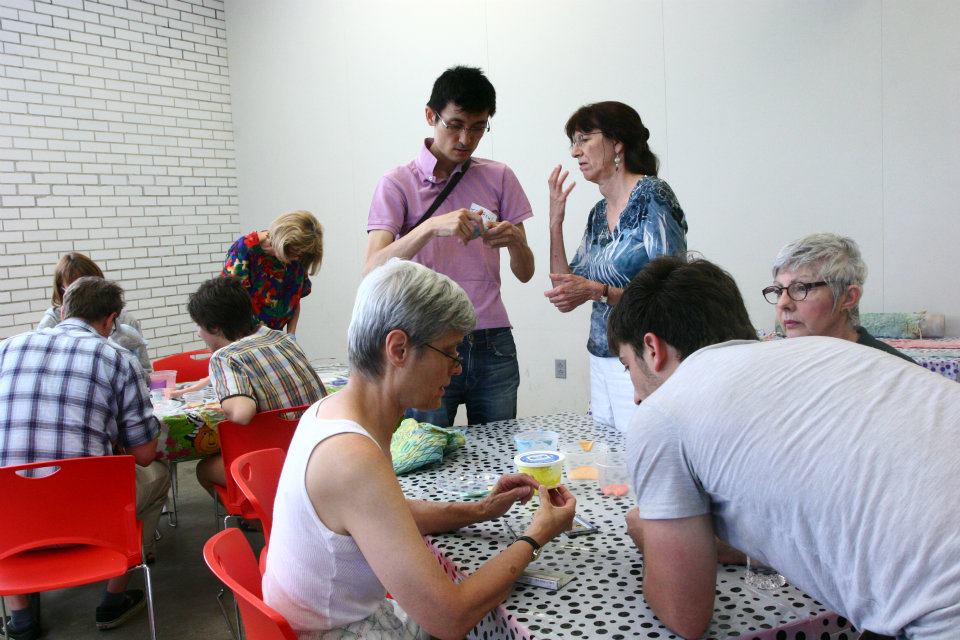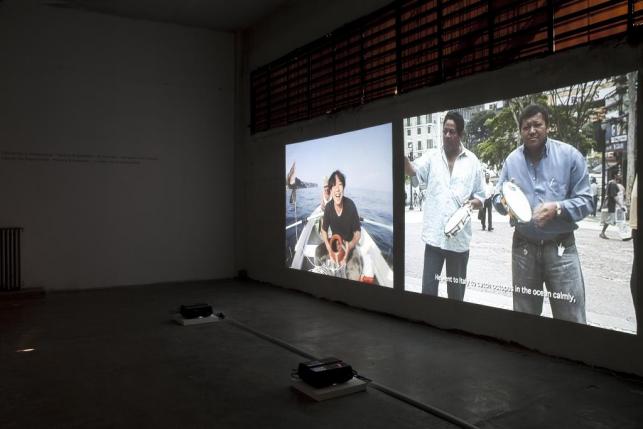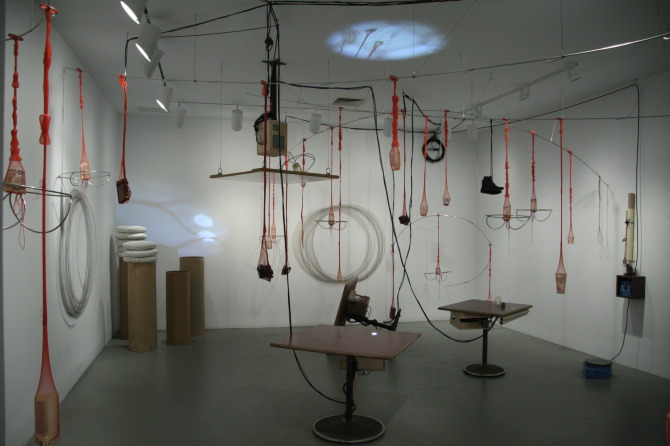
Takashi Horisaki. Social Dress St. Louis: Learning and Unlearning, 2012. Workshop at OASIS Institute in St. Louis, MO. ©Allison Woodworth.
Often, by being in close proximity to another person, you find that you unconsciously start to influence each others’ thinking, and even each others’ work. Over the past year or so my husband, artist Takashi Horisaki, and I have found our interests converging in spite of the differences between our personal aesthetics and practices. Having spent the last few weeks deeply involved in the planning, administrative support, and installation of his latest endeavor, which opened at the Contemporary Art Museum St. Louis last night, I again sensed similarities in our concerns about materiality and live interaction (which I include within the term “performative”).
The project he has been working on over the past few months, Social Dress St. Louis: Learning and Unlearning, is part of an ongoing series of works, entitled Social Dress, which considers how the social and/or political fabric of a site is relates to local architecture, urban planning, and history. The works are sculptural, made of thin layers of cast liquid latex to create a fabric-like impression of the surface of an object or architecture, and are produced in collaboration with community members, as well as local cultural and civic organizations. In each iteration of this series, he visits the community to get an on-the-ground feel for the concerns most relevant to that site, and this sets the tone for the project, influencing the groups he reaches out to and the issues he tries to address.

Takashi Horisaki. Social Dress Buffalo: the Past Reflecting the Future, 2010. Installation view at Mason Gross Galleries, Rutgers University, NJ.
While there is a material outcome of the project, it is really these interactions, both in the preparation for production, and in the production process, that form the core of the project. Takashi’s concept is to allow the artmaking process to become a catalyst for informal, unstructured dialogue, but set in a situation and with a set of players that might be able to address the issues he sees as most pressing in that community with the hopes of facilitating non-standard, non-hierarchical communication. In Social Dress Buffalo: the Past Reflecting the Future (2010), he was especially concerned with the plight of city neighborhoods filled with abandoned homes that the city was having difficulty dealing with and that most local college students had never visited. Working with a group of architecture, urban planning and art students–-individuals who could eventually find themselves in the position to make decisions about the future of this community–-he cast sections of these abandoned homes, placing the students in a position to both experience and possibly get to talk with curious local residents. In the end, many of these students were stopped by local residents who wanted to know what they were up to, giving them the opportunity to talk with these community members about what it was like to live in those neighborhoods and what they felt were their most pressing concerns. The final structure created from these casts was a geodesic dome, imagined as a space that could both promote contemplation and house further dialogue.
In Social Dress St. Louis:Learning and Unlearning (2012), this interaction came in the form of workshops held around the city and hosted by local organizations, in which residents came to cast objects of personal significance and tell their stories about the objects in an effort to paint an alternative image of the city aside from the socioeconomic divides that have come to dominate descriptions of St. Louis’ recent history. The objects themselves became the conduit through which the participants could communicate personal concerns, identity and minor histories of the city, with the casts of their objects taking on the status of records–of their stories, of these interactions, and of the components of a community. The material objects displayed in the museum are only one component of the artwork itself, but their production facilitates a shift in the conversation, a move away from overarching generalizations that are often fed by a combination of mass media sound bites and niche-communities promoted by the format of the internet, toward substantive one-on-one interactions that take into account nuance and exception.

Shimabuku. Asking the Repentistas – Peneira & Sonhador – to remix my octopus works, 2006. Installation view at Galleria Zero, Milan, Italy.
Attending a recent lecture by Shimabuku at the New Museum, I was struck by how Takashi’s approach—facilitating personal stories through the making of objects–is in a sense the inverse of one of Shimabuku’s best known works, Asking the Repentistas – Peneira & Sonhador – to remix my octopus works (2006). In this two-channel work, based around one of Shimabuku’s octopi videos in which he created traditional Japanese ceramic vessels to catch octopi, then got an incredulous fisherman in Italy to take him on a boat to test them out, he runs a second channel in which two Brazilian street singers sing a ballad they compose about Shimabuku, after the artist showed them the octopus video and they attempted to speak with him about the meaning of the video, despite not sharing a common language.
In this case, the object could alternately be considered the first video or the ceramic vessel which initiates all the subsequent exchanges. In either case, though, Shimabuku employs the object as means of facilitating an interaction, but rather than revealing their existing stories, this interaction generates a new, muddled story that uncovers the personal biases and imagination of the other participant. In the Brazilian singers’ ballad, Shimabuku is transformed into a fisherman, the greatest fisherman in Japan, but a kindly fisherman who returns his catch to the sea. According to the artists’ commentary, Shimabuku had attempted to explain that he was an artist, but the singers apparently could not accept that what he was doing was an artwork, and so interpreted him as a fisherman instead. The object thus becomes facilitator for an interaction that is just as revealing of the personal, but in this case, rather than personal concerns, it is the personal imagination, exploring how we read and misread the world around us.

Aki Sasamoto. Strange Attractors, 2010. Installation view at the Whitney Museum of American Art, New York.
Looking further into the interpretive potential of objects, Aki Sasamoto designs constellations of hybrid knickknacks and constructions based on personal experiences. These might include goggles in which the lenses have been replaced with lemons, tables embedded with microphones and video cameras, or cups full of liquid or resin, suspended within plastic mesh tubes. They each related to a particular sensorial or conceptual experience that the artists had in connection with a specific event, but Sasamoto only specifically ties them together through the performance itself.
In works like Beauty Lines (2010), she may put on the lemon glasses in order to impair her vision and conjure the stinging pain of sweat drops she experienced during her first attempts at boxing. Wearing these glasses, Sasamoto holds onto a line strung around the room, knocking into and over obstacles placed in the way until she encounters the robe, lined with speakers replaying the comments of her gruff boxing instructor, in which she envelops herself. In literally navigating the space with the facilitation or impediment posed by these objects, she navigates these disparate elements of her memories so as to create a new interpretation, and hopefully a new understanding, of the significance of that event. The interaction, addressed in the past tense, is picked apart and reprocessed by the performance through the facilitation of new, novel objects, but as interesting as these objects might be, they still stand merely as markers and conduits for observation of an interaction.
These disparate practices still seem to boil down to the same basic idea, that the material world is more appropriately thought of as a facilitator for, and record of the substance of life: interaction, conversation, and imagination. This is the idea I would like to close with. Anxieties about the material world focus on the commercial thrust of consumer economies which place the object at the focal point of daily life, imaging acquisition of objects as the end goal of human existence. What these and many similar artists propose in exploring relationships between objects and performance, is a shift toward the object as an important support for, but always remaining secondary to, the primary objective: conversation, interaction and experience.




